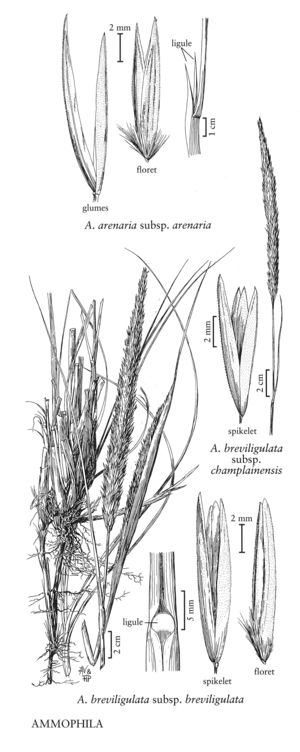Difference between revisions of "Ammophila breviligulata subsp. breviligulata"
FNA>Volume Importer |
imported>Volume Importer |
||
| (5 intermediate revisions by 2 users not shown) | |||
| Line 1: | Line 1: | ||
{{Treatment/ID | {{Treatment/ID | ||
|accepted_name=Ammophila breviligulata subsp. breviligulata | |accepted_name=Ammophila breviligulata subsp. breviligulata | ||
| − | |accepted_authority= | + | |accepted_authority= |
|publications= | |publications= | ||
|common_names=American beachgrass;Ammophile à ligule courte | |common_names=American beachgrass;Ammophile à ligule courte | ||
| Line 25: | Line 25: | ||
-->{{#Taxon: | -->{{#Taxon: | ||
name=Ammophila breviligulata subsp. breviligulata | name=Ammophila breviligulata subsp. breviligulata | ||
| − | + | |authority= | |
| − | |authority= | ||
|rank=subspecies | |rank=subspecies | ||
|parent rank=species | |parent rank=species | ||
| Line 32: | Line 31: | ||
|basionyms= | |basionyms= | ||
|family=Poaceae | |family=Poaceae | ||
| + | |illustrator=Linda Ann Vorobik;Hana Pazdírková | ||
| + | |illustration copyright=Utah State University | ||
|reference=None | |reference=None | ||
|publication title= | |publication title= | ||
|publication year= | |publication year= | ||
|special status= | |special status= | ||
| − | |source xml=https:// | + | |source xml=https://bitbucket.org/aafc-mbb/fna-data-curation/src/200273ad09963decb8fc72550212de541d86569d/coarse_grained_fna_xml/V24/V24_1104.xml |
|subfamily=Poaceae subfam. Pooideae | |subfamily=Poaceae subfam. Pooideae | ||
|tribe=Poaceae tribe Poeae | |tribe=Poaceae tribe Poeae | ||
Latest revision as of 16:21, 11 May 2021
Flag leaf blades 5-39 cm. Panicles (9.5)13-40 cm. Glumes 8-15 mm; lemmas 8-11.5(14) mm; anthers 3.5-7 mm. 2n = 28.
Discussion
Ammophila breviligulata subsp. breviligulata grows on sand dunes and dry, sandy shores from around the Great Lakes to the Atlantic coast from Newfoundland to South Carolina and, as an introduction, on the west coast. Anthesis is from late July to September. It hybridizes with Calamagrostis canadensis on Grand Island, Michigan, and the adjacent mainland, to form xCalammophila don-hensonii Reznicek & Judz. The hybrid is morphologically intermediate between its parents. Most florets appear to be sterile; some appear normal. Discovery of a plant that appears to be a backcross to Calamagrostis canadensis supports the possibility that some of the hybrid seed is functional.
Selected References
None.
